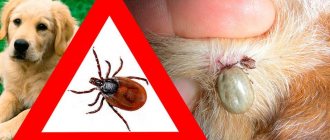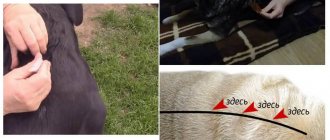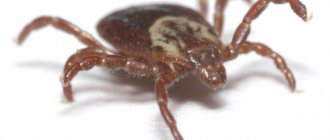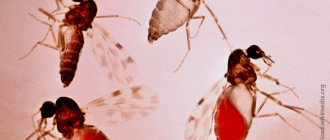The danger of scabies to the body
A dog becomes infected with scabies mites during contact with a sick animal or in a roundabout way - through soil, grass, human clothing, on which the parasite can live for two weeks.
Even a lap dog can become infected with scabies if the owner brings the mite into the house on shoes or clothing. The causative agent of scabies is the scabies mite, which a dog can become infected with through direct contact with a sick animal.
The causative agent of scabies is a mite of the genus Sarcoptes canis - a microscopic parasite, 0.5 mm in size, which is almost impossible to see with the naked eye. Once on the dog's fur, the tick penetrates the epidermis and begins to feed on tissue fluids.
Single specimens that get on the dog’s fur and penetrate into the dog’s skin begin to make passages and spread throughout the body. In tunnels reaching 3 mm per day, the parasites lay eggs, from which new specimens hatch. The life cycle of a female lasts 15 days, during which time she is capable of producing up to 50 eggs.
The peak infection of animals with scabies mites occurs in autumn and winter; it is less common to become infected with it in the summer. Dogs have no breed or age predisposition to infection, so any dog can suffer from scabies. At the same time, scabies mites pose the greatest danger to puppies. Their immunity is underdeveloped, and the likelihood of developing complications is quite high.
Sarcoptic mange (or scabies) is dangerous due to inflammation of the skin and the resulting depletion of the dog’s body. The skin reacts to mite waste products with the formation of infiltrates and hyperkeratosis. It is the infection brought into the inflamed skin that poses a danger to the dog. If the parasite is not destroyed in time and skin treatment is not started, the dog will die.
Symptoms and varieties
The main symptom of scabies is increasing itching, which is associated with irritation of the nerve receptors of the skin damaged by mites. Other manifestations of the disease will vary somewhat depending on the type of pathogen.
On a note! Mites that live on the skin of dogs are not able to develop and reproduce on human skin, but can cause pseudoscabies - an allergic reaction of the human body to the presence of parasites, which can manifest itself in the form of itching. In such cases, specific treatment is not required, except for drugs for symptomatic relief of itching.
Cheyletiosis
Another name for the disease is wandering or pityriasis scabies - one of the contagious varieties. Cheyletiellayasguri mites most often settle on the surface of the skin of the neck, ears, (sometimes back), feeding on tissue fluid and dying cells. Characteristic symptoms:
- severe inflammation of the affected areas;
- hair loss, often in clumps;
- the appearance of a rash or ulcers, which over time transform into hard scales and crusts.
On a note! With cheyletiosis, dandruff appears, but in reality it is mites that move around the dog's body and look like dandruff particles. This explains the name “wandering scabies”.
Sarcoptic mange
The popular name for the disease is pruritic scabies. In this case, areas with short hair are most often affected: the nose, eyebrow areas, ears, joints of the limbs. The Sarcoptescanis mite penetrates into the deep subcutaneous layers, where it gnaws passages to lay eggs.
The first symptom of sarcoptic mange is small dots, which after 10-14 days turn into small itchy sores. This scabies resembles a flea infestation with corresponding characteristic biting. In addition, it is observed:
- restless dog behavior due to parasite bites;
- scratching the affected areas until they bleed, followed by the formation of crusts and scabs;
- “ear reflex”, when, when touching the shell of the ear, the dog immediately tries to scratch the affected ear behind the paw;
- hair loss in affected areas;
- the formation of a rash and ulcers is possible.
Otodectosis
The disease is caused by the Otodectescynotis mite, which affects the inner surface of the ears, which is why it is also called ear scabies. It is transmitted from one animal to another through prolonged contact and is most often found in long-eared dog breeds. The tick feeds on the blood of the animal and, as it matures, strengthens itself in the upper layers of the skin, causing severe itching. Specific symptoms:
- brown sticky plaque in the ear (mite waste);
- frequent shaking of the head and tilting towards the affected ear;
- constant attempts to rub his head against the owner and surrounding objects.
Attention! In the absence of timely treatment, the ear mite makes its way into the middle and inner ear, and then affects the meninges, which can lead to deafness, meningitis and even death for the dog.
Demodicosis
Demodicosis is caused by the Demodex canis mite, which affects the skin and internal organs of the animal. The parasite has a cigar-shaped appearance and lives near the sebaceous glands and in hair follicles.
A pet becomes infected from other dogs, and this often happens during the molting period, when there is no hair in the follicle. The tick crawls there and moves deeper. But in weakened animals, with a decrease in skin tone, the parasite can penetrate into the gap between the hair and the funnel of the hair follicle.
By gnawing passages in the epithelium, the parasite allows other mites to penetrate the same follicle, forming a whole focus-colony of mites. The products of their vital activity have a toxic effect on the dog’s liver, which ultimately destroys it.
Doctors divide the disease into forms:
- Scaly;
- Pustular;
- General.
In the scaly form, areas of flaking form on the animal’s skin, and dandruff appears in large quantities. With pustular pustules, pustules appear under the skin - compactions no larger than a centimeter in size. Blood and purulent discharge come out of them, which dry out and turn into crusts. In the general form, mixed symptoms of the other two appear - both scales and pustules are formed.
The dog develops oxygen deficiency due to impaired skin respiration and increased heat transfer. If the disease is neglected, it becomes chronic with hardening of the superficial lymph nodes. And with a weakened body, pathologically irreversible processes are possible, leading to the death of the animal.
Notoedrosis
The mite that causes scabies settles in the deep layers of the dog's epidermis. It is able to move easily, so it quickly affects surrounding animals, especially young individuals. The following symptoms indicate infection:
- incessant itching and irritation;
- small bubbles and nodules on the face, ears, back, stomach;
- “folding” of the affected areas of the skin;
- hair loss.
Wandering scabies
This disease is considered one of the most contagious, as it can appear not only in a pet, but also in humans. Its causative agent is the mite Cheyletiella yasguri, which uses tissue fluid and dead skin as its main source of nutrition. Most often, this harmful insect affects the ears, neck and back of the animal.
Symptoms of scabies mites in dogs vary. The degree of their manifestation depends on the size of the affected area and the breed of the pet. The main signs of wandering scabies:
- Hair loss in the parasite's habitat and the formation of scabs. This process is observed only in certain areas of the skin surface. In addition, the hair may not fall out, but sag in lumps.
- The appearance of large dandruff. Quite often you can observe how scabies mites move it from one place to another.
- Regularly scratching tick-infested areas. It occurs due to severe itching and leads to the formation of bloody lesions on the skin.
- Inflammation and suppuration of wounds. This symptom leads to additional discomfort and an increase in the dog's body temperature.
Types of disease
Scabies in pets is caused by various types of mites that attack different layers of the skin. Animals have no age or breed predisposition to infection, so parasites can attack any dog. Ticks are dangerous for small puppies who do not have a developed immune system to fight the complications and consequences of the disease.
Sarcoptic mange
Sarcoptosis is a disease caused by the small tick mite Sarcoptes scabiei, which lives primarily on dogs. The peculiarity of the disease is severe itching, poorly controlled by medications.
The scabies mite easily penetrates the body and multiplies intensively, going through all stages of development from larvae to adult. It parasitizes under the skin, feeding on biological material: interstitial fluid, lymph, serous exudate and dead epithelial cells. There he gnaws passages where he lays his eggs. Ticks can also attack humans, causing pseudosarcoptosis, but these parasites do not reproduce in human skin and do not gnaw passages.
The first symptoms of the disease are reddened spots on the skin, mainly in areas with short hair: on the head, knee and elbow joints, and lower abdomen. As the disease develops, the entire surface of the body is captured, fistulas, purulent wounds can form, and a secondary infection can occur. Outside the host, ticks do not reproduce, but are able to survive and remain mobile for up to 50 days, depending on environmental conditions.
Demodicosis
Demodicosis is caused by the Demodex canis mite, which affects the skin and internal organs of the animal. The parasite has a cigar-shaped appearance and lives near the sebaceous glands and in hair follicles.
A pet becomes infected from other dogs, and this often happens during the molting period, when there is no hair in the follicle. The tick crawls there and moves deeper. But in weakened animals, with a decrease in skin tone, the parasite can penetrate into the gap between the hair and the funnel of the hair follicle.
By gnawing passages in the epithelium, the parasite allows other mites to penetrate the same follicle, forming a whole focus-colony of mites. The products of their vital activity have a toxic effect on the dog’s liver, which ultimately destroys it.
Doctors divide the disease into forms:
- Scaly;
- Pustular;
- General.
In the scaly form, areas of flaking form on the animal’s skin, and dandruff appears in large quantities. With pustular pustules, pustules appear under the skin - compactions no larger than a centimeter in size. Blood and purulent discharge come out of them, which dry out and turn into crusts. In the general form, mixed symptoms of the other two appear - both scales and pustules are formed.
The dog develops oxygen deficiency due to impaired skin respiration and increased heat transfer. If the disease is neglected, it becomes chronic with hardening of the superficial lymph nodes. And with a weakened body, pathologically irreversible processes are possible, leading to the death of the animal.
Otodectosis
The culprit of otodectosis, the mite Otodectes cynotis, settles in the auricle and ear canal of wild carnivores, cats, ferrets, dogs, and rarely in humans. Once infected, the animal rubs its ears against various objects, injuring the skin, and shakes its head. Pets with large drooping ears often get sick in warm and humid environments. With this auricle there is a favorable habitat for ticks.
The ear canal is filled with viscous purulent contents, sulfur and mite waste products, causing inflammation. It can spread to the inner ear, leading to deafness, and the brain. The animal's body temperature rises, nervous attacks and a depressed state are possible. The owner may suspect something is wrong if the dog constantly holds its head tilted towards the affected ear.
Cheyletiosis
The disease is caused by the ear mite Cheiletiella yascuri, which feeds on the interstitial fluid and lymph of the animal. When infected with this mite, the hair on the ears, back and neck thins and does not adhere well to the skin. Increased skin pigmentation, purulent rash, itching appear, crusts and areas of baldness form.
The peculiarity of the infection is severe peeling of the skin and a lot of dandruff containing live mites (wandering dandruff), so the disease is contagious. People can be attacked by ticks, but the parasite does not live long on human skin and cannot survive.
Notoedrosis
The disease is caused by the subcutaneous tick Notoedres cati, which affects dogs, cats, rabbits, and people. You can get infected from a pet, but the tick retains its vital capacity on human skin for no more than 30 days (an unusual host).
The disease manifests itself as painful itching and skin irritation. As inflammation develops, the skin becomes covered with a yellow-gray scab, thickens, wrinkles, and areas of baldness may form.
Difference between scabies and other skin diseases
There are few diseases similar in appearance to scabies, so diagnosing the disease yourself is quite simple.
The following diseases are similar to scabies mite infestation:
- Otodectosis, or ear scabies (see ear diseases in dogs). Normally, the causative agents of this disease develop on the inside of the ear, but in the final stage the parasite can spread to the face and neck. In this case, the bulk of the damage will be located in the ears. With classic scabies, the parasites inside the ear do not multiply.
- Demodecosis. The causative agent of this disease settles in the hair follicles, so it does not cause itching. With demodicosis, hair loss begins without changes in the skin.
- Allergic eczema. It has the maximum similarity of symptoms with scabies. Externally, the nature of the skin damage is almost the same, so dog breeders may mistake an allergic reaction for scabies. A distinctive feature of allergies is the absence of scabs on the skin. With an allergy, the adhesive liquid is not released, and the dog’s skin does not become crusty, it only turns red and inflamed.
Symptoms of the lesion
Scabies mites have a bad habit of living under the skin of their victims, feeding on the composition of the soft layer of the epidermis. It only takes 20-30 minutes for the creatures to crawl under the skin and lay their eggs there. Animals are usually very nervous in such situations, displaying outward anxiety and characteristic behavior. Dogs affected by ticks can be divided into several types of diseases:
- Sarcoptic mange is scabies.
- Demodectic mange is a severe infection caused by ticks.
- Otodecosis (or “ear mite”) - has a localized habitat on the animal’s body - the inside of the ears.
The first type of lesion actually relates directly to scabies. The second type is simply a severe form of infection of the dog with subcutaneous parasites; it may more closely relate to one of the stages of infection with scabies. But the third disease is also classified as scabies, but most often it is not called that for some reason, even though it is caused by mites. There are other subtypes of the disease - notoedrosis, cheyletiosis and other stages.
Symptoms mainly appear in the evenings and at night, when scabies parasites are most active. Here are the main symptoms that indicate that your pet has scabies:
- the animal rushes about, whines or whines very much;
- the pet can roll on the ground, floor, rub its sides against corners and sharp objects;
- loss of appetite, difficulty sleeping;
- increase in body temperature by 1 or 2 degrees;
- noticeable irritation and a constant desire to scratch (the so-called “ear-foot” reflex);
- allergic itching can cause mucus to flow from the dog's nose, as well as red, painful spots on the skin of the body;
- the presence of a red spot on the body, which grows over time and is very itchy, and then festeres;
- the hairline falls off;
- the skin turns grey, red and rough.
When the sore has just appeared in a dog, it may not even itch, but only make attempts - it raises its paw to scratch it, and then it seems to freeze, whine, cannot find a place for a normal, restful sleep, etc. Most often, the dog's body is covered with red, hard swellings in the following places: stomach, back, (lumbar part), ears, hips and chest.
How dangerous is the disease?
Itching mites are aggressive creatures that will not leave their host without special treatment. The longer they stay in the body, the more significant harm they cause to dog health:
- Decreased immunity. A constantly itchy dog loses its appetite and interest in life. As a result, the resulting exhaustion has a bad effect on the immune system.
- Intoxication. As ticks multiply, the products of their vital activity accumulate in the body. They enter the blood, which leads to intoxication of the entire body.
- Penetration of infections. By scratching its skin, the animal inflicts wounds and scratches on itself, creating an entry point for various infectious diseases.
- Pathogenic microflora. Inflammation of skin areas provokes the occurrence of dermatitis. Areas of irritation become crusty, disrupting skin heat exchange and oxygen penetration. This creates conditions for the proliferation of pyogenic bacteria, staphylococcus, streptococcus.
As a result of these factors, the dog’s cardiovascular and nervous system is disrupted, which leads to the development of side pathologies.
Symptoms and stages of development of scabies in dogs
Aggressive external parasites, which include scabies mites, do not leave their host “voluntarily.” Timely detection of pests and effective treatment will save your dog from the harmful effects of the disease. The main symptom of scabies is severe itching. The animal constantly itches, becomes nervous, loses appetite, and immunity decreases. Toxic waste products of ticks enter the bloodstream, which leads to a deterioration in the general condition of the pet. Scratched areas of the skin become additional sources of infection. A progressive disease can lead to serious disruptions in the functioning of the respiratory and cardiovascular systems, and if scabies is not treated promptly, it can lead to death.
Symptoms of scabies mites
Sarcoptic mange and notoedrosis differ from each other in the location of the foci of localization of the disease.
Important!
Scabies mites prefer places on the dog's body with thin and sparse hair, as well as with delicate sensitive skin.
The presence of sarcoptic mange is indicated by redness and irritation of the skin in the head, chest, tail root, and abdominal cavity. In male dogs, lesions may appear on the foreskin. The causative agents of notoedrosis primarily occupy the dog's head, affecting the bridge of the nose, forehead, outer surface of the ears, and the delicate skin above the eyes. Next, the ticks move to the front and hind limbs.
On a note!
Dry air and heat increase the itching, while cold brings some relief to the dog.
The first signs of the disease appear approximately 14 days after infection. It develops in stages and has the following characteristic symptoms:
- nervousness and anxiety of the dog;
- the affected skin turns red, itches severely, and hair loss occurs;
- ulcers, papules, fistulas, deep infected wounds appear, skin bleeding is possible;
- extensive growth of affected areas throughout the dog’s body, formation of scabs and disruption of heat transfer processes;
- keratinization of epidermal particles that look like large dandruff.
The presence of any of these symptoms in an animal should alert the owner. You should immediately contact your veterinarian and use a laboratory test to confirm or deny the presence of scabies in your dog.
Development of the disease
At the first stage, redness appears on the skin and the pet begins to itch. Unfortunately, at this stage, owners do not pay attention to the symptoms and do not even suspect the presence of the disease. After all, it is quite normal for a dog to scratch itself and there is no reason to immediately examine the skin and suspect a problem.
Next, small red dots called pustules begin to appear on the skin. They are filled with liquid and when the animal itches they burst. In places of pathological foci, hair begins to fall out, and the skin becomes very rough. Rejected skin particles also appear, they are very similar to dandruff.
The skin condition worsens, loses elasticity and becomes rougher. Moreover, when such areas are scratched, the skin cracks and bloody cracks appear. The condition of the coat also deteriorates significantly; in the affected areas it falls out intensively, and in other areas it becomes dull. The dog refuses to eat and begins to lose a lot of weight.
Quite often other infectious diseases develop, which significantly complicates the general condition. It is worth saying that only a specialist can diagnose the disease after examination. Everyone experiences the disease differently, and symptoms may vary.
Methods to combat a dangerous disease
Timely and properly selected treatment for scabies mites is the key to the health of your pet. The doctor, based on the test results, selects effective antiparasitic drugs. The initial stage of the disease does not require long-term treatment, unlike the advanced form.
On a note!
The dog should not be bathed until examined by a specialist. The procedure will reduce the likelihood of detecting a pathogen in the scraping.
Methods to combat scabies mites
Therapy for scabies in dogs involves an integrated approach to solving the problem. The course of treatment may include the following sequence of actions:
- Removing hair from affected areas of the skin.
- Water procedures using acaricidal drugs according to a scheme developed by a doctor. Using shampoos with birch tar and chlorhexidine has a positive effect.
- Local treatment of the animal's skin with antiparasitic solutions, sprays, Stronghold drops (price varies from 890 to 1300 rubles), Advantage (estimated cost 1800 rubles), Frontline Combo (approximately 800 rubles) and other drugs.
- Injections with drugs containing ivermectin. The dosage and number of injections is determined by the veterinarian depending on the severity of the disease, breed and individual characteristics of a particular dog.
Treatment of scabies at home can be carried out using an effective domestically produced medicine - Amidel gel NEO. It contains cyfluthrin, lidocaine, glycerin and other auxiliary components that provide a high therapeutic effect from the use of the combined drug. The gel has proven itself not only in the initial stages of the disease, but is also used in combination with ivermectin injections in difficult situations. Affordable price - 170-190 rubles. for a 10-gram dispenser syringe makes the drug available to consumers.
Treatment of scabies in dogs
If all the veterinarian's recommendations are correctly followed, scabies treatment is carried out quickly and without harm to the animal. In the initial stages of the disease, it is sufficient to use special antiparasitic drugs that have a detrimental effect on the parasite and remove it from the body.
Advanced stages involve the use of anti-parasite agents, as well as drugs that restore damaged areas and increase the dog’s immunity.
Chemicals
The following medications can be used to eliminate scabies mites in dogs:
- Amidel gel Neo is a drug produced in the form of an ointment. The action of the drug is aimed at eliminating mites and reducing unpleasant symptoms.
- Stronghold - produced in the form of drops, the product is applied to places where the dog cannot lick the substance. To treat scabies mites, you need to apply drops once to the fur in the withers area.
- Creolin solution - allows you to completely eliminate all parasites and their eggs. It is necessary to bathe the animal in the solution, avoiding contact with the eyes and mouth.
- Agtichlor - must be rubbed into the affected areas several times a day.
- Ecomectin is prescribed for subcutaneous administration of the drug. Eliminates ticks and activates the body's natural defenses.
Good to know! When using products with a chemical composition, it is necessary to wear special collars on the animal to prevent poisoning.
Folk remedies
Alternative treatment methods can be used for minor tick infestations on animals.
The most commonly used:
- garlic and oil. It is necessary to chop the garlic and mix in equal proportions with sunflower oil. The resulting composition must be infused for two days, after which the affected areas should be lubricated with the infusion several times a day;
- tar. The use of tar allows not only to eliminate adult parasites, but also to destroy the larvae. It is necessary to lubricate the areas where scratching is observed with tar and leave for 4-5 hours, then rinse with warm water. Duration of treatment until symptoms disappear;
- turpentine. Rub the substance once a day into the damaged areas. Leave for several hours, then remove with soapy water;
- laundry soap – you need to wash your pet with laundry soap and leave for a few minutes. Washing must be done every two days.
Let's celebrate! The use of traditional treatment methods can reduce unpleasant symptoms in dogs, but the disease can be completely eliminated only after visiting a veterinarian who will prescribe the necessary treatment, depending on the type of disease.
Treatment options
It is very difficult to treat dog scabies, so only an integrated approach will help solve the problem. Getting rid of ticks will take a lot of time and expensive medications. A sick pet will have to endure several unpleasant procedures that may affect its mental state. Because of this, veterinarians advise surrounding a sick dog with care and passing on your love to it.
All diseases caused by various ticks can be cured using the following measures:
- Maintaining hygiene rules. An important step in getting rid of scabies mites is maintaining ideal conditions for your pet. Every day you should wash your pet's rug in hot water and dry it thoroughly in the open air.
- Taking into account safety tips. Protective gloves should be used during any contact with animals. This will not only protect the owner from becoming infected with ticks, but will also reduce the likelihood of additional problems for the pet. In addition, you should limit your dog's interaction with other people.
- Strengthening the immune system. The fight against parasites must be carried out in all directions, including activating the work of the animal’s body’s defense system. For this, highly qualified veterinarians advise using special tablets. They contain not only vitamins and minerals, but also substances that help cope with ticks. However, such drugs are expensive and can only be found in large veterinary pharmacies. You can replace them with Tetravit and Gamavit. These two medications are available as a solution for subcutaneous administration and help strengthen your pet's immune system.
- Regular bathing using special anti-tick shampoos. This option is the safest, as it practically does not harm the pet. Special products help quickly get rid of ticks and prevent their reproduction. The only contraindication is the presence of eczema on the pet’s body.
- Use of broad-spectrum acaricidal agents (Permanon, Breeze, Tsifoks and others). These medications come in drop form, making them easy to mix into your dog's food. They must be used at certain intervals and in strict dosages. Such products will help eliminate not only parasites, but also the eggs they lay.
- The use of hepatoprotective drugs (Karsil, Divopride, Ornitil and others). These medications must be given to the dog, as they will help reduce the negative effects of other medications used on the liver.
- Following a certain diet. During treatment for scabies mites, it is recommended to give your pet only those foods that will not cause an allergic reaction. It is best to feed the animal with special high-quality food. It should contain many vitamins and minerals, as well as special additives that prevent dysbacteriosis.
- Treatment with folk remedies. They can be used only at the initial stage of treatment, since in the future they will be ineffective. Lavender oil is considered the best folk medicine of natural origin. It will help little in the fight against mites, but will help reduce itching and quickly heal damaged areas.
Treatment of demodicosis, sarcoptic mange and notohedrosis
Neither internal nor external parasites should be ignored. The sooner treatment begins, the easier it will be to get rid of itching and the less likely there are complications. Acariasis is treated with medication. This usually happens at home. To understand which ticks have infected a four-legged patient, a veterinarian will only need to examine him and analyze the signs of the disease, but laboratory tests will be required to make an accurate diagnosis. Only after receiving laboratory test results, the doctor develops a treatment regimen. Self-medication is not recommended. Wrong actions can aggravate the situation, jeopardizing not only the health, but also the life of the pet.
Preparations in drops and sprays
You can get rid of itches using drops and sprays (Stronghold, Bars, Ivermek, Bravecto). Drugs in this form act against several types of parasites and are intended for topical use. They must be used in strict accordance with the manufacturer's recommendations. If the dosage is violated and the duration of treatment is exceeded, you can harm your pet. Information on what drops and sprays will help cure acariasis in a dog is presented in the table:
Treatment of scabies
Therapy is carried out at home. To treat scabies, external and internal drugs are used. The treatment regimen is prescribed individually for each clinical case, assessing the pet’s condition.
During therapy, it is important to be careful when in contact with an infected animal; if possible, you should not touch the affected areas or wear disposable gloves. After all procedures, hands must be washed thoroughly.
Drops
They are produced on the basis of an acaricidal substance that is effective against most types of ticks. For treatment, the drug is applied to the animal’s withers and along the spine. The effect of the drops reaches its maximum effect a day after application. For small puppies and bitches during pregnancy, the veterinarian selects the most gentle drops.
Treatment with drops is carried out once a month, but in the warm season the drug should be used more often, since the pet is in daily contact with the ground, dew, and plants that may contain ticks. In addition, swimming in bodies of water significantly reduces the effectiveness of the drops.
Pills
This is the least common form of medication to treat scabies. This is due to the fact that tablet drugs represent a new generation of medicines. The principle of action is as follows: after taking the drug, the active substances saturate the dog’s blood and it becomes “unpalatable” to ticks.
By the way, the tablets used in veterinary medicine have a pleasant taste; pet owners have no problems feeding them to their dogs.
In accordance with the instructions, tablets are taken once every three months.
Sprays and aerosols
An alternative remedy that is used every ten days. The product is not very convenient in treating large breed dogs, since the pet must be treated completely. For small dogs, the spray is an excellent solution to the problem.
Prevention of demodicosis in dogs
The main task is to eliminate conditions for the reproduction of ticks, which means maintaining the dog’s immunity:
- Once a quarter, the pet is taken for a preventive veterinary examination in order to identify hidden diseases at an early stage and treat them in a timely manner.
- Do not violate the vaccination schedule.
- The pet's area is kept clean and dry.
- Balanced food.
- Contact with obviously sick animals is limited.
- Regularly treated against external and internal parasites.
To prevent parasitic diseases, it is better to use universal remedies so as not to give several drugs. Bravecto, Simparica, and Frontline Nexgard tablets protect against ixodid, demodectic, ear, sarcoptic ticks and fleas. Nexgard Spectra, Advocate drops, in addition to the listed parasites, destroy roundworms and heartworm larvae.
Demodicosis in dogs is an unpleasant but curable disease, photos, treatment, symptoms depend on the clinical form and area of the lesion.
Weeping, wet and dry eczema in dogs: causes and photos of symptoms
Eczema in dogs, or summer scabies, is a fairly common skin disease among animals, including canines. In terms of symptoms, it is similar to mite scabies and ringworm. To exclude false diagnoses, you must first submit a sample for analysis.
Veterinarians are familiar with two forms of eczema: acute (moist, wet) and chronic (dry). Any of them usually appears in the summer.
Wet eczema in dogs, like all acute forms, develops quickly. Severe redness of the skin appears, the dog itches, and watery blisters form on the skin. Then the hair begins to fall out, the skin takes on a glossy, moist appearance. Most often, the acute form of eczema occurs in dogs of long-haired breeds.
Dry eczema in dogs does not make itself felt immediately, so if any inflammation, rash, causeless hair loss, or peeling accompanied by severe itching appears, you should immediately go to the doctor. This form of eczema most often affects wire-haired breeds.
Weeping eczema in dogs usually appears at the base of the tail, along the back and on the shoulder blades. The acute form is easily recognized by brownish discharge around the ear canal and between the toes.
Causes of eczema in dogs may include: local irritation of the dog's skin (from dirt or some chemicals), heat and poor diet, and nervous stress. It’s not for nothing that easily excitable dogs are more likely to get eczema, as are people with nervous disorders or metabolic disorders.
One very common type of eczema is caused by a microscopic fungus called Alternaria tenuis, which lives in dead grass and fallen leaves. Like most mushrooms, it loves moist, hot weather.
Eczema is not spread from a dog to another dog or person. If skin problems have spread to another dog, you need to urgently test for an infectious skin disease. The following shows eczema in dogs in the photo, which allows you to recognize the symptoms of the disease in an animal in time:
Before you begin to treat eczema, you need to remove skin irritants, wash your dog, and if the eczema is caused by lice or fleas, kill them. It often turns out that this is enough to combat eczema.
Treatment should be comprehensive and preferably early. First of all, it is necessary to act on the underlying cause within the body. Since the trophic function of the nervous system is always impaired in eczema, it is advisable to use short novocaine blockades or blockades of nodes and sympathetic ganglia at all stages. In the weeping stage, treatment of eczema is delayed, and it becomes chronic. After treatment, relapses are possible.
At all stages, for desensitization, it is advisable to administer a 10-20% solution of sodium thiosulfate intravenously, starting with 1-2 ml, adding 1 ml daily. A total of 10 injections are required.
To normalize trophic function and reduce exudation in the first stages before the formation of pustules, inject a 0.25% solution of novocaine with hydrocortisone (1 ml of novocaine solution 1 ml of hydrocortisone), and for more advanced forms it is recommended to add 1-2 ml of ampoule gentamicin. The solution is injected into several places on healthy skin so that it penetrates under the eczema-affected skin.
Dog fleas in dogs and their photos
Fleas in dogs not only poison the animal's life, but can also be carriers of worms. There are mainly four types of fleas that parasitize dogs: canine, cat, human and suction fleas. Human fleas can live on dogs, cats and pigs. Felines prefer cats, but if they are not nearby, they are content with dogs. The dog flea prefers dogs, but will not miss an opportunity to bite a person. Sucking fleas also live on birds and can bite humans.
Female fleas produce a large number of eggs, which fall on the ground, floor, and upholstery. After a few days, they hatch into worm-like larvae, which after two weeks or more (depending on temperature and humidity) reach maturity and spin cocoons around themselves the size of a grain of wheat.
From these cocoons, after another week or several months, fleas appear, which try, if possible, to crawl to a height of 30 cm from the ground, floor, etc. Here they wait for a passing dog or other warm-blooded animal to jump on it and settle in their new "dwelling".
Look at what fleas look like on dogs in the photo to be able to recognize parasites in a timely manner:
Sticky fleas, unlike the other three species, do not jump from place to place, but choose a permanent home. In dogs they are usually located on the ears, and often a dog's ears are lined with hundreds of these parasites.
How do dogs get these parasites?
The usual way for an animal to become infected with parasites such as scabies mites is through close contact with the infested object. Such an object can be, and not even just another animal, but even a person. All it takes is for your dog to walk with another dog who has this disease, and your pet can catch this nasty thing. Most rarely, infection occurs from contact with the environment, because in the external environment there are practically no conditions for the active development and residence of ticks. The sun alone is enough for ticks to die from the temperature and dryness of the atmosphere.
Ringworm in dogs: photos and treatment
Ringworm in dogs combines three infectious diseases - trichophytosis, microsporia and scab, the causative agents of which are pathogenic dermatophyte fungi. These diseases have similar symptoms and treatments. They are also dangerous for people.
In dogs, ringworm begins as small spots, usually round or oval, covered with a gray or tan crust. Almost all hair falls out of these affected areas. The spots appear most often on the face, head or paws, but can also appear in other places. As the disease progresses, the bald spots increase. The spots disappear after a while, but appear in a different place. When a dog scrapes off the scab to relieve the itching, a bleeding wound remains at the site. Sometimes there is little or no itching. Look at the photos of ringworm in dogs that show the symptoms of this parasitic disease:
For an accurate diagnosis, doctors examine hair from the affected areas under a microscope. For microsporia, fluorescent diagnostics are performed using a mercury-quartz lamp with a Wood filter. This analysis is necessary because ringworm is caused by several types of fungi, and depending on the type, treatment is prescribed. Moreover, the appearance of bald patches, which you can independently diagnose as lichen, in 20-30% of cases turn out to be symptoms of other diseases. They may be signs of vitamin deficiency or a weakened body.
Based on the results of the examination of the animal, the doctor will prescribe a treatment regimen, which will be based on the following measures (one or more): the use of vaccines for preventive and therapeutic purposes; prescription of specific antifungal drugs; taking immunomodulators; local treatment of affected skin areas with antiseptics.
When treating ringworm in dogs, it is very important to observe personal safety measures: collect and burn rejected crusts and hair and disinfect the room and care items.
Acne is the result of inflammation of the hair follicles or sebaceous glands. In dogs, pimples often appear under the collar, where dirt and germs are rubbed into the skin. A boil or carbuncle may appear at the site of the pimple.
A ripe pimple is opened, the pus is washed off and the wound is moistened with some non-irritating antiseptic such as hydrogen peroxide. Ichthyol ointment, if vigorously rubbed into a nascent pimple, can kill microbes from the inside and the pimple will disappear.
Is it possible to protect a dog from scabies mites?
Prevention of dog infection with scabies consists of regularly examining the animal to identify the first signs. It is impossible to completely protect a dog from getting parasites on its fur.
Regularly treating your dog's skin against external parasites is an excellent measure to prevent scabies.
Reasonable measures must be taken to:
- Do not walk your pet in areas where stray animals live.
- Changing the place of walking if an animal with scabies is spotted on the site.
- Regularly treat the dog's skin with antiparasitic drugs. The protective drug BlochNet, which is dripped onto the dog’s withers at the intervals recommended by the instructions, has proven itself well. The same product can be used to treat your pet's bedding.
- Periodically carry out antiparasitic treatment of places where the pet is kept: enclosure, booth, bed.
If you strictly follow the recommendations of specialists, scabies in a dog can be cured quickly and completely. After treatment, the dog needs enhanced nutrition and a course of fortification to maintain immunity.
We invite you to watch a video showing a puppy affected by scabies mites.
Treatment methods for scabies mites
To treat animals, both conventional products that are used on humans and specialized products produced by manufacturers specifically for the treatment of scabies in dogs (or cats) can be used. Among the main veterinary drugs, not all can show their effectiveness, but most specifically act on parasites , killing them and healing wounds. Animals are treated according to the following algorithm:
- Carefully examine the dog - parting its fur and inspecting the infected skin.
- A scraping is done with the help of a veterinary laboratory assistant, a specialist.
- They are treated with insecticidal shampoos , liquid medications, or you can use a tick remover.
- Bath the dog thoroughly.
- After drying, all wounds and ulcers are coated with wound-healing preparations .
Among the many shampoos, aerosols or ointments, we can note the most popular options that have shown themselves to be positive. This is Aerosol “A-PAR” or “Spregal”, sulfur ointment , as well as an ointment that is made on the basis of turpentine. The most suitable drugs for treating dogs are Benzyl benzoate and Lindane lotion . Permethrin (or another) is applied with a cotton swab. Then, after treating the dogs, they wash their hands thoroughly, and the animal itself should be isolated and supervised so that it does not wander around the premises.
What is a scabies mite?
Veterinarian recommendations
Dogs infested with ticks should be clipped as soon as possible. Long hair does not contribute to treatment - it also obstructs air flow and causes irritation.
Hair trimming is the first step in preparing the skin for further treatment. The skin must be thoroughly cleansed using special products.
It is recommended to use shampoos, antipruritic drugs, and also give the dog anti-scabies after the end of therapy to prevent relapse of the disease.
It is also worth disinfecting brushes, combs, toiletries and other dog accessories, as mites can remain on them for several weeks.
Sources
- https://sobaki-pesiki.ru/chesotka-u-sobak-simptomy-lechenie.html
- https://usatiki.ru/chesotka-u-sobak-simptomy-i-lechenie/
- https://dog-care.ru/zdorove/bolezni/chesotka-lechenie.html
- https://kleshun.ru/chesotochnyj-klesh/
- https://KlopVred.ru/kleshhi/chesotochnye-kleshhi-u-sobaki/
- https://apest.ru/kleshhi/kleshhi-u-zhivotnyh/chesotochnyj-kleshch-u-sobak/
- https://deziplan.ru/kleshhi/o-kleshhax/chesotochnyj-kleshh-u-sobak.html
- https://VrediteliSOS.ru/nasekomye/kleshhi/podkozhnyj-kleshch-u-sobak.html
- https://vokrugsobak.ru/demodekoz-u-sobak-foto-lechenie-simptomy-preparaty/
- https://mirsobaki.ru/chesotka-u-sobak/
- https://www.1001dog.com/polezno-znat/vneshnie-kozhnye-parazity-u-sobak-i-ix-simptomy-na-foto.html
[collapse]











